Last Updated on October 29, 2024
If you live in an area with frequent dry spells, finding plants that can thrive in your garden can be a challenge. Drought-tolerant ground covers are a great solution, as they are low maintenance, water-efficient, and can add visual interest to your garden. Here are 14 low-growing drought-resistant ground cover plants perfect for dry climates.
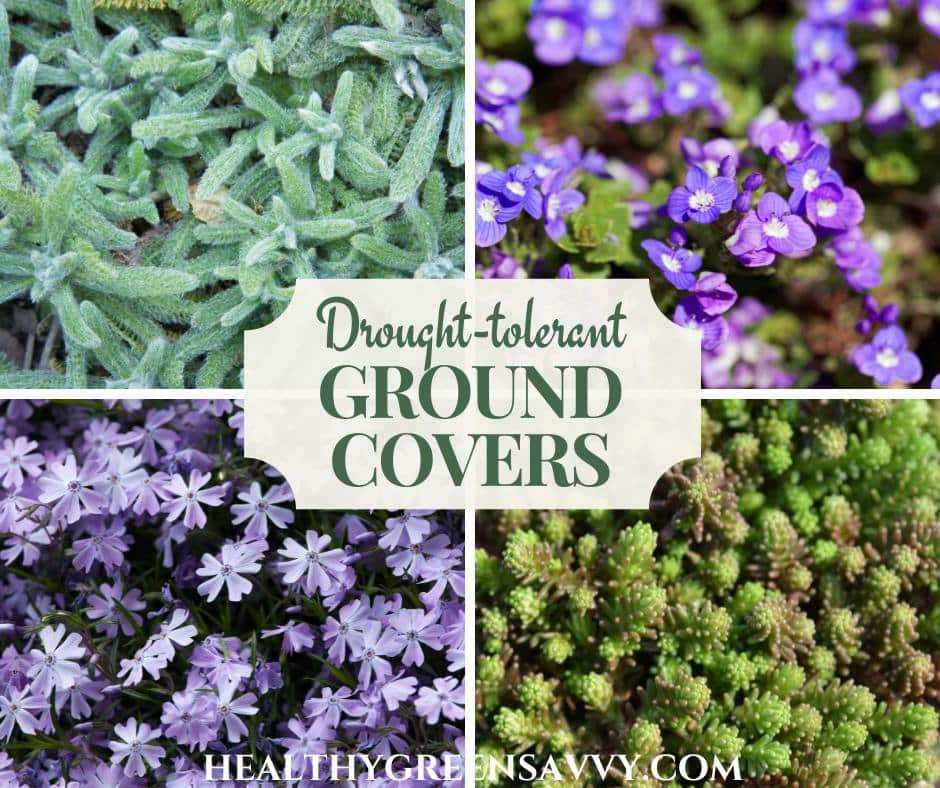
- WHY PLANT DROUGHT-TOLERANT GROUND COVERS?
- WHAT MAKES A GROUND COVER DROUGHT-TOLERANT?
- BEST DROUGHT-TOLERANT GROUND COVERS
- SEDUMS
- CREEPING THYME
- OREGANO
- RUPTUREWORT (HERNIARIA GLABRA)
- WOOLLY YARROW (ACHILLEA TOMENTOSA)
- SOAPWORT (SAPONARIA OCYMOIDES)
- BEARBERRY (ARCTOSTAPHYLOS UVA URSI)
- ICE PLANT (DELOSPERMA)
- CREEPING ROSEMARY (ROSMARINUS OFFICINALIS "PROSTRATUS")
- CREEPING PHLOX (PHLOX STOLONIFERA)
- TURKISH SPEEDWELL (VERONICA LIWANENSIS)
- NAILWORT (PARONYCHIA KAPELA)
- TALLER GROUND COVER PLANTS TO CONSIDER
WHY PLANT DROUGHT-TOLERANT GROUND COVERS?
Climate change has meant climate challenge, especially for those living in areas already prone to drought. Even if you don’t live in such an area, you may have faced drought conditions in more than one season in recent years. Preparing your garden to make do with less water is an important strategy for adapting to our changing climate. Here’s more about gardening in a changing climate from the Sierra Club.
Experts predict that 4 out of 5 states in the U.S. will face water shortages in the near future. If you haven’t already downsized or gotten rid of your grass lawn altogether, there’s no time like the present. Less grass also means less climate pollution from lawn mowing, which also contributes to the growing problem of noise pollution.
Here’s what to know about grass alternatives like a flowering bee lawn, including the easiest ways to convert your lawn to drought-tolerant ground covers.
Other options for replacing lawn include herbal ground covers you can use in your home apothecary, one of many ways to make your yard more eco-friendly with ecological landscaping.
WHAT MAKES A GROUND COVER DROUGHT-TOLERANT?
Drought-tolerant ground covers are plants that can thrive with very little water. Some drought-tolerant plants have deep taproots that can go far into the soil to find the moisture they need. Others have succulent leaves that store water for when it’s needed.
Some plants are considered extremely drought tolerant, while others are less so. The key is that they don’t need the frequent waterings that a grass lawn requires to stay green.
HOW TO CHOOSE DROUGHT-TOLERANT GROUND COVERS
Before buying and planting your drought-tolerant ground covers, you need to consider several things:
- Light — Is the area sunny or shady?
- Foot traffic — Do you want to be able to walk in this area? Some ground covers can handle foot traffic better than others.
- Height — Do you want something that stays very low to the ground, or is 6-12 inches OK?
- Area to cover — Will you plant a large or a small space with ground covers or just tuck them in among taller perennials?
- Bloom time — If you’d like flowers over a long period (great for pollinators!) consider when different plants bloom. The longer you provide food for insects, the more your garden supports your local ecosystem.
WHERE TO BUY DROUGHT-RESISTANT GROUND COVERS
Most nurseries and garden centers will carry at least a few of the drought-tolerant ground covers listed below. Look for them with other plants sold as ground covers.
You can also find many of them online, where you may be able to get varieties not sold in garden centers.
One of my favorite places to shop for drought-tolerant plants is High Country Gardens, which has a wide range of plants for dry conditions.
The company Stepables specializes in ground cover plants you can walk on, though you can’t buy directly from them online. You may find their signature ‘Stepables’ logo on plants at garden centers. Their site lists a large number of plants you can limit to the conditions you’re looking to suit.
BEST DROUGHT-TOLERANT GROUND COVERS
SEDUMS

Also known as stonecrop, sedums are succulents with thick, fleshy leaves that allow them to store water, so they can survive long periods without additional irrigation. If you’re looking for a drought-resistant ground cover, you’ll have plenty of sedums to choose from. There are over 400 sedum species!
Many varieties of sedum only grow a few inches tall and form mats that work as ground covers. Some to consider include cascade stonecrop (Sedum divergens), Angelina stonecrop (Sedum rupestre ‘Angelina’), Chinese or coral reef sedum (Sedum tetractinum ‘coral reef’). You may find others at your local nursery.
Light: Some sedums prefer full sun, while others can handle part shade
Height: 2 to 6 inches
Soil: prefers well-drained soil with pH between 6 and 8
Foot traffic: no
Growing zones: 3 to 9
CREEPING THYME

Thyme is not only an extremely drought-tolerant ground cover, it’s also a versatile culinary and medicinal herb.
One of the best varieties of thyme to use as a ground cover is woolly thyme, which has attractive silvery foliage and can withstand foot traffic. Several other types of thyme grow in low mats, such as lemon thyme and variegated thyme. Be sure to check the hardiness of these plants to ensure they’re suited to your climate.
Thyme is also an excellent companion plant. Here’s more about companion planting with rhubarb and elderberry companion plants if you’re curious.
The thymes used as ground covers can be used the same ways as upright thyme, though they’re not as easy to harvest. Ground cover thymes can be used in cooking or in medicinal preparations.
Thyme is one of the best herbs for cough and is valued as an herb for colds and flu. Try this easy thyme tea recipe to help address respiratory symptoms.
If you’re interested in preserving thyme for winter use, here’s what to know about how to dry thyme.
Light: Prefers full sun, but can handle part sun
Height: 2 to 3 inches
Soil: prefers well-drained soil with pH between 6 and 8
Foot traffic: Some thymes stand up to foot traffic better than others. Try woolly thyme, other thymus praecox cultivars, or thymus serpyllum cultivars
Growing zones: 4 to 8
OREGANO
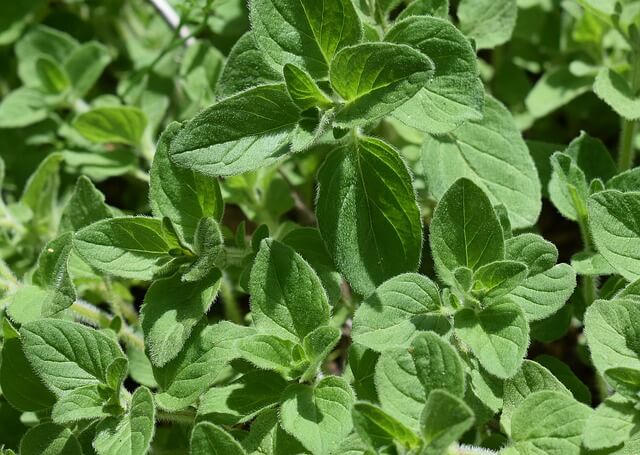
Oregano is a wonderfully flavorful herb that can be used as a drought-tolerant ground cover. For a low-growing ground cover, you’ll want oregano varieties with a creeping habit. The lowest-growing variety is Origanum vulgare ‘Humile,’ which is hardy in zones 6 to 11. In colder climates, Greek oregano is a good choice, as it tends to form a mat as well. Taller types of oregano are a bit easier to harvest.
Encourage oregano to spread by pinching off the top growth throughout the season. If you have a big enough patch, you can mow it.
Light: Full sun to part shade
Height: 3 to 24 inches (depending on variety)
Soil: neutral, well-drained
Foot Traffic: some varieties
Growing zones: 4 to 11, depending on variety
RUPTUREWORT (HERNIARIA GLABRA)
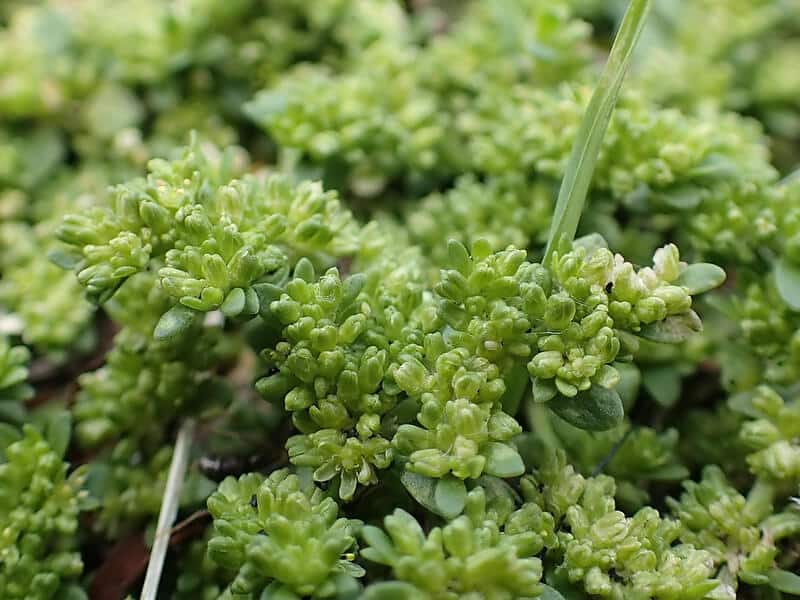
Rupturewort’s name comes from its usefulness in addressing skin ruptures. Its Latin name alludes to its historical use in treating hernias. Rupturewort’s diuretic properties have been used to address bladder and kidney conditions.
One of rupturewort’s other key virtues is that it stays green year round, leading to one of its nicknames, green carpet. Rupturewort also tolerates poor soil. You can find seeds here (though note the seller lists hardiness zone 6-10).
Light: full sun to part shade
Height: 3 inches
Soil: acidic to neutral
Foot traffic: Yes
Growing zones: 5 to 9
WOOLLY YARROW (ACHILLEA TOMENTOSA)

A low-growing type of yarrow, woolly yarrow’s low water needs and toughness makes it an excellent drought-tolerant ground cover. Woolly yarrow grows to form a dense mat studded with yellow flowers that pollinators will visit at midsummer.
Yarrow has numerous medicinal uses. Especially prized for healing wounds, it’s also helpful for reducing fevers and relieving pain. Learn more about yarrow uses and benefits.
Light: Full sun
Height: 6 to 8 inches
Soil: Prefers drier soils
Foot traffic: Can handle light foot traffic
Growing zones: 3 to 7
SOAPWORT (SAPONARIA OCYMOIDES)

An exceptionally tough drought-tolerant ground cover, soapwort manages in cold climates, producing blooms to adorn your garden for up to a month. A vigorous self-seeder, it will spread readily in the garden. Cut it back after flowering if you want to keep it from spreading.
Light: Full sun
Height: 4 to 5 inches
Soil: Prefers drier soils
Foot traffic: Can handle light foot traffic
Growing zones: 3 to 8
BEARBERRY (ARCTOSTAPHYLOS UVA URSI)

Bearberry (Arctostaphylos uva ursi) can tolerate poor soil as well as cold climates. It spreads into an attractive green mat studded with red berries. Bearberry’s leaves are used in herbal medicine as a diuretic, anti-inflammatory, and astringent. The European Medicines Agency has approved bearberry leaves for addressing mild UTIs. Note that risks of liver damage and drug interactions mean anyone considering taking bearberry should proceed with caution.
Light: Sun to part shade
Height: 6 to 12 inches
Soil: Prefers acidic soils
Foot Traffic: No
Growing zones: 2 to 6
ICE PLANT (DELOSPERMA)
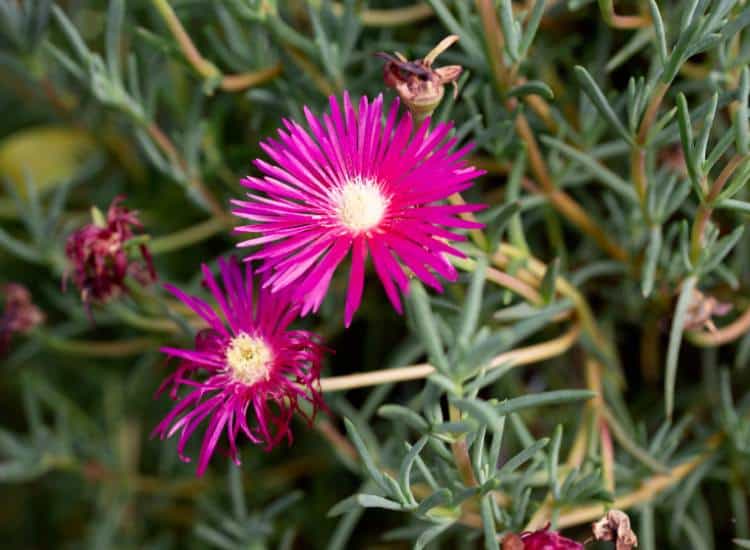
Ice plant (Delosperma) is native to arid areas of southern Africa and therefore is suited to warm, dry climates. With profuse daisy-like flowers that bloom for many weeks, ice plant makes a vibrant ground cover. Ice plants will have purple, yellow, or white flowers depending on the variety. When not in bloom, ice plant has evergreen foliage.
Light: Full sun, may tolerate part shade
Height: 6 inches
Soil: Prefers poor soils
Foot Traffic: No
Growing zones: 5 to 10
CREEPING ROSEMARY (ROSMARINUS OFFICINALIS “PROSTRATUS”)

Creeping rosemary (also known as prostrate rosemary) has a greener color and brighter flavor than its silvery upright cousin common rosemary. I think the flavor of creeping rosemary is superior, so I grow it as an annual because it’s not perennial in my area.
Though you’ll see descriptions of creeping rosemary list its height as up 12 inches, you can encourage it to spread and stay close to the ground by layering its stems. If a stem reaches higher than you’d like, hold it down with a small stone and cover part of it with some soil. It will grow roots at that spot and behave more like a ground cover than an upright herb.
Light: Full sun
Height: 2 to 12 inches
Soil: Well-draining, neutral pH
Foot traffic: No
Growing zones: 8 to10
CREEPING PHLOX (PHLOX STOLONIFERA)

Creeping phlox sports profuse blooms in spring, and then has attractive green foliage through the rest of the season. One of the more versatile drought-tolerant ground covers, creeping phlox can thrive in all types of soils, from clay to sand, acidic to alkaline.
Because it’s a common landscape plant, you may be able to get a division from a neighbor, a great way to score loads of free plants.
Light: Full sun
Height: 6 inches
Soil: tolerates a range of soil conditions, acid and alkaline, clay or sandy
Foot Traffic: No
Growing zones: 3 to 9
TURKISH SPEEDWELL (VERONICA LIWANENSIS)

A very low-growing speedwell variety, Turkish speedwell (Veronica liwanensis) has evergreen foliage that turns purplish in winter. Growing only 2 inches tall, Turkish speedwell spreadly slowly up to 2 feet wide. It produces a profusion of beautiful blue flowers in late spring that make it a stunning replacement for lawns.
Light: Sun to part sun
Height: 1 to 2 inches
Soil: tolerates clay or sandy soils
Foot Traffic: Yes
Growing zones: 3 to 10
NAILWORT (PARONYCHIA KAPELA)

High Country Gardens calls nailwort (Paronychia kapela) tough as nails, but that’s not actually where nailwort’s name comes from. Both the common and Latin names come from the infection around the fingernails nailwort was traditionally used to treat.
Regardless, nailwort is indeed tough, reportedly more drought-resistant than thyme. Growing only 1 to 2 inches high, nailwort spreads as much as a foot. It has tiny green leaves like thyme that turn orange in fall. Some sources claim that it only grows in warmer climates, zone 7 and higher, but High Country Gardens says theirs grows in zones 4 to 8.
Light: Full sun to part shade
Height: 1 to 2 inches
Soil: prefers well-drained soil but can tolerate range of pH conditions
Foot Traffic: tolerates light foot traffic
Growing zones: 4 to 10
TALLER GROUND COVER PLANTS TO CONSIDER
Though the term ‘ground cover’ typically indicates low-growing plants, some taller drought-tolerant plants prone to spreading might be worth considering adding to your water-wise landscape.
LAVENDER (LAVENDULA SSP.)
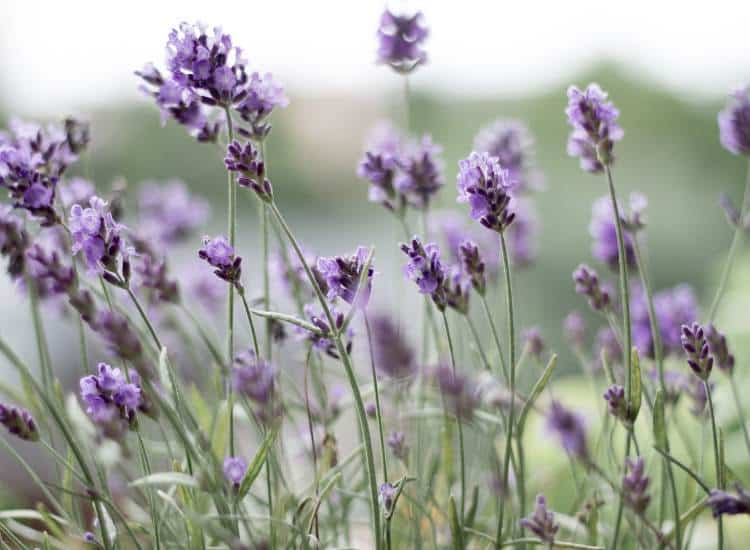
Though lavender may be on the tall side to consider a ground cover plant, if you choose one of the lowest-growing cultivars (like Thumbelina Leigh), lavender may work as an accent with other low-growing ground covers, and it will spread nicely to cover ground where you need it to.
Best of all, you can use the beautiful lavender flowers for all sorts of things, from aromatherapy to tea. Try them in lavender bath salts, or add them to herbal tea blends. Most people don’t realize you can also use the leaves. Here are 11 ways to use lavender leaves worth exploring.
Light: Sun
Height: 12 to 15 inches for dwarf varieties
Soil: prefers well-drained neutral to slightly alkaline soils
Foot Traffic: No
Growing zones: 5 to 9
WINE CUPS (CALLIRHOE INVOLUCRATA)
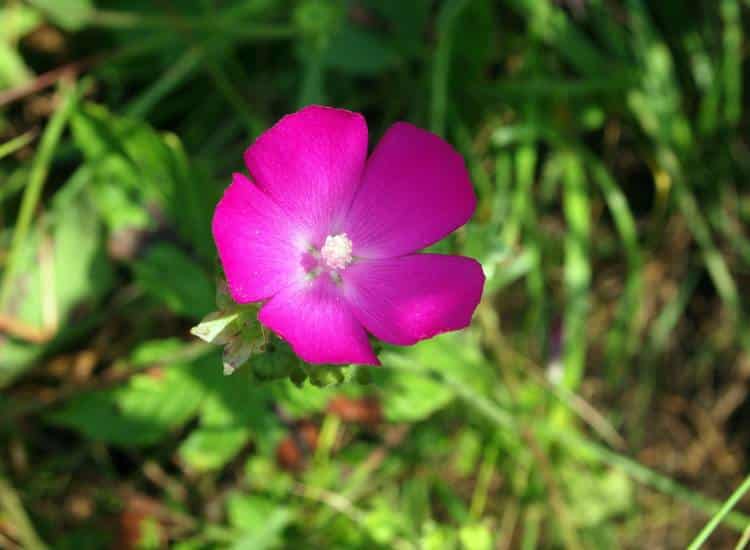
Also known as purple poppy mallow, this tough prairie plant can thrive in poor soil and go without water for many weeks thanks to its long taproot. Its showy flowers begin to bloom in early summer, and bloom time can be extended for up to two months if you deadhead spent blooms before they go to seed.
Winecups are normally grown from seed, as the taproots don’t like to be disturbed once established.
Light: Full sun to part shade
Height: Up to12 inches
Soil: Can handle poor soils
Foot Traffic: No
Growing zones: 4 to 8
There are many more drought-tolerant ground covers to explore at Stepables, though finding the plants to purchase may not always be easy. Read the details about these plants carefully, so you’re buying something appropriate for your growing conditions. Some dislike winter moisture or need well-drained soil, so if you have clay or wetter winters, you’ll want to skip those.
Some additional drought-tolerant ground covers to consider:
- Moss campion
- Alpine mouse ear (Cerastium alpinum lanatum)
- Creeping wire vine
- Pussytoes
- Snow in summer
- Angelita daisy
- Creeping betony
- White star creeper
- Blue star creeper
- Vinca minor
- Germander
- Miniature wormwood
- Creeping cinquefoil
What drought-tolerant ground covers might you grow in your yard?
Save this info on drought-tolerant ground covers for later!

Drought-tolerant ground covers photo credits: skymoon13, weisschr, wrangel, Nahhan, gyro, Birute

Susannah is a proud garden geek and energy nerd who loves healthy food and natural remedies. Her work has appeared in Mother Earth Living, Ensia, Northern Gardener, Sierra, and on numerous websites. Her first book, Everything Elderberry, released in September 2020 and has been a #1 new release in holistic medicine, naturopathy, herb gardening, and other categories. Find out more and grab your copy here.


 Hi, I'm Susannah, a garden geek, energy nerd, and fan of healthy food and natural remedies. Need some simple, practical solutions for living healthier and greener? You've come to the right place! More about me and my green projects
Hi, I'm Susannah, a garden geek, energy nerd, and fan of healthy food and natural remedies. Need some simple, practical solutions for living healthier and greener? You've come to the right place! More about me and my green projects
Leave a Reply